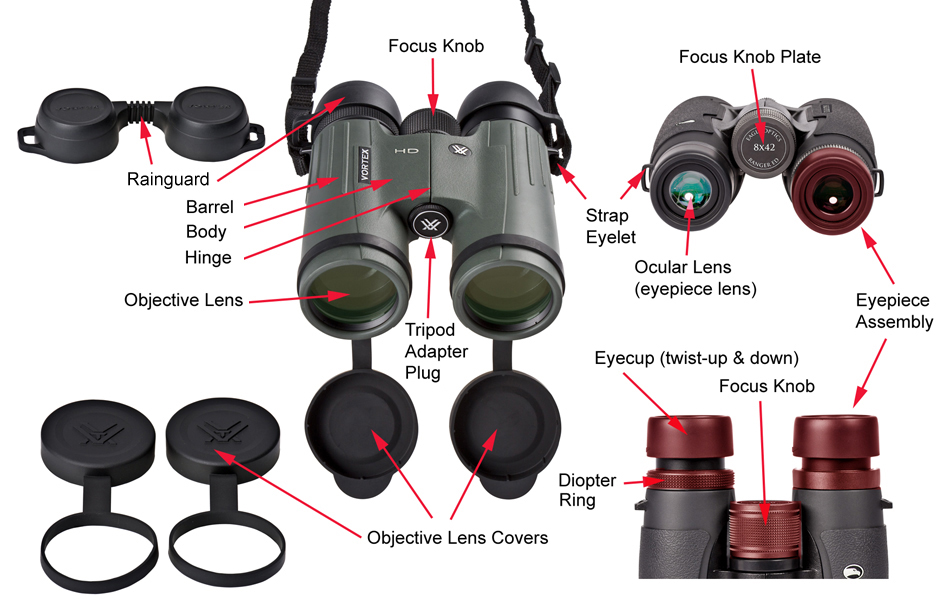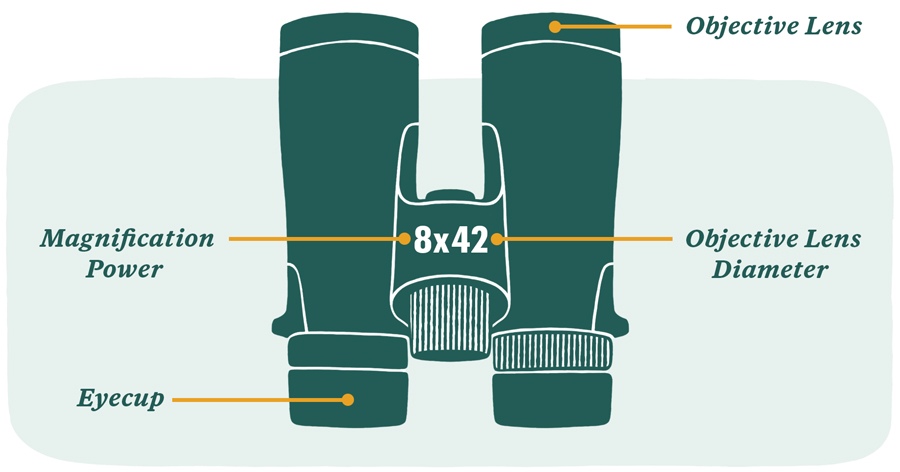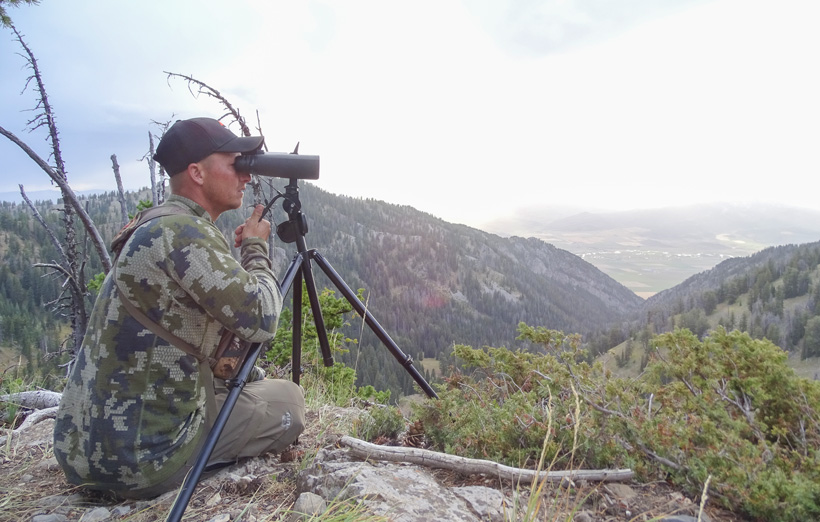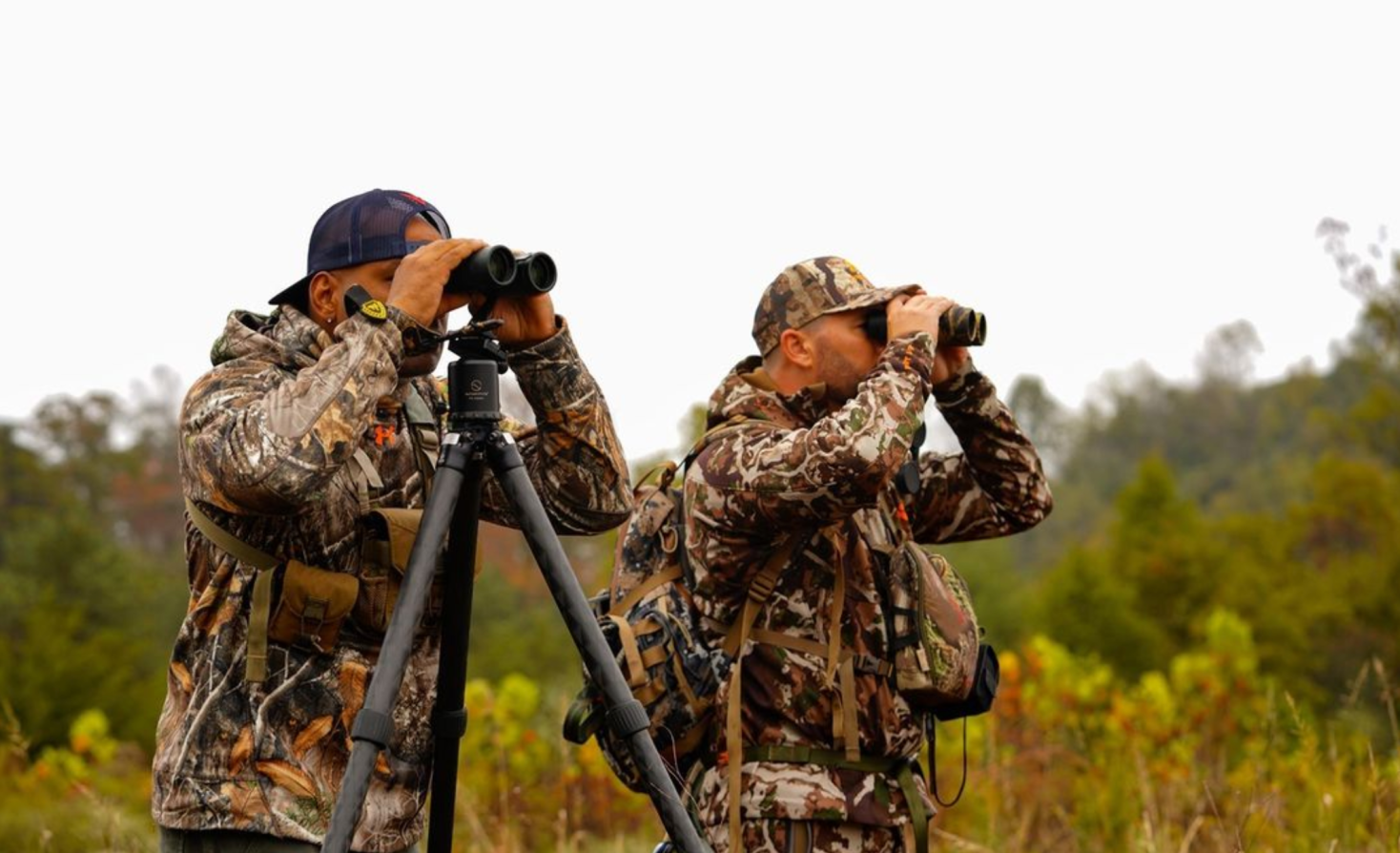We may earn revenue from the products available on this page and participate in affiliate programs. Learn More ›
If you’re in the market for a set of binoculars, you’ll notice there are many options, even for the same model. These different models have numbers like 10×42 and 15×56. What do the numbers on binoculars mean? By the end of this article you’ll fully understand binocular specs and anatomy, so you can choose the best binoculars for you.

Binocular Anatomy
Binoculars have three main parts: the objective lens, prisms and the ocular lens. Binocular lenses are thicker in the middle and taper out to a thinner edge, which bends light toward the middle. These lenses are called converging lenses because the light converges in the middle and this light bending characteristic causes objects to appear larger when you look through them. The same lens shape is used for magnifying glasses. If you take two converging lenses and put them on either end of a tube you’ll have a crude telescope. Those two lenses are called the objective and ocular lens, more on those in the section, “What do numbers on binoculars mean?”But as you look through it, you’ll notice that the image you’re seeing is upside down. A set of prisms solves this issue by reversing the image. Binoculars are basically just two of those telescopes. By having two tubes, instead of one, we increase the amount of area we are able to see, which is the main advantage of binoculars over monoculars.
Here are some other parts of binoculars you should know.
- Focus Ring: The focus ring is located between the two barrels. Rotating this ring brings objects into focus. You’ll need to adjust focus when looking at objects at different distances.
- Eye Cups: The eye cups are located on the end of the binoculars you look through. Extend the eye cups if you aren’t wearing glasses and keep them collapsed if you are wearing glasses.
- Diopter Adjustment: The diopter is an adjustable ring that is usually located near the right eyecup. The diopter adjustment makes up for differences in clarity between your eyes. To set your diopter cover the right barrel with your hand and adjust the focus wheel so that you see a clear image with your left eye. Then cover your left barrel. If the image you are seeing with your right eye isn’t sharp, adjust the diopter until you see a crisp image. Your diopter is now set.
- Tripod Adapter Connection: On the front of the binocular’s hinge there is a threaded insert for a tripod adapter to screw into. These are usually covered, but can be found with the help of your owner’s manual. The tripod adapter allows your binoculars to mount to a tripod head for stable glassing.

What do numbers on binoculars mean?
The numbers on binoculars indicate the magnification and size of the objective lens. For example, one of the most common magnification and objective sizes is the 10×42 (spoken as 10-by-42). The 10x in 10×42 is the magnification. The higher the magnification the closer an object will appear when looking through that set of binoculars. For example, if you want a pair of binoculars for spotting small things that are far away, a 15 power would be more appropriate than an 8 power. If you want to be able to see a wider area, called field of view, you should choose a lower power like an 8 power. The second number is the size of the objective lens. A larger objective lens gathers more light, but it also adds bulk and weight. For example, a 10X56 will have better lowlight capabilities than a 10×42, but it’ll also be larger and heavier.
- Eye Relief: The distance from your eye to the eye cups. This specification is especially important for glasses wearers. A larger eye relief will be more forgiving if you wear glasses and will allow you to see the full field of view without vignetting.
- Field of View: The field of view is how much area you can view at once when looking through binoculars. This specification is typically given in the amount of area you can see at a certain distance. For example, 315 feet at 1000 yards. Field of view is also specified as the angular field of view, which can help you calculate how much area can be seen at various distances.
- Close Focus: If you are looking at objects near and far, then the close focus is an important spec. It tells you the closest you can view an object with it still being in sharp focus.

Tips for Buying Binoculars
When buying a set of binoculars consider how you’ll use them. Will you be using them at dusk and dawn? Are they going to be used in dense woods or open country? Do you need to see fine detail like if a deer is doe or button buck? Are you using them handheld? These factors and your budget will help you decide which binoculars are the best for you.
First let’s figure out what power and objective is best for you. If you’re hunting whitetails in timber, want maximum field of view, or need lightweight and compact binoculars, an 8 power is for you. If you want a versatile set of binoculars you can use for whitetails one day and put them on a tripod to glass mule deer the next, a set of 10 power binoculars is for you. If you are mostly interested in binoculars to use on a tripod for glassing basins or judging antlers, a 12 or 15 power is the ticket. The size of the objective lens you’ll choose depends on how much weight and bulk you’re willing to handle. For example a set of Vortex Razor HD 10×42 binoculars weigh 24.8 ounces. The 10×50 Razor HD weighs 28.1 ounces and is an inch longer than the 10×42 binoculars.
Binoculars can range in price from $30 to more than $3,000, and you typically get what you pay for. There’s no magic pair of $100 binoculars that will be as good as a $2,000 pair. But, how much you need to spend will depend on how much performance you need. If you’ll be spending hours looking through your binoculars and you need them to perform well in low light, it’s probably best to save up for the best glass you can afford. If you aren’t as concerned with seeing fine details there are a wide range of budget friendly binoculars that have a lot of performance for the price. When making your final decision, consider that different manufacturers use different coatings that won’t appeal to everyone’s eyes. That’s why ultimately, the proof is in the looking. Get your hands on a variety of binoculars and look through them to see what looks best.
People Also Ask
What magnification binoculars should I buy?
For most applications, you can’t go wrong with 10×42 binoculars because they offer a balance of good field of view and magnification. The most common multi-purpose magnifications for binoculars are 8 power and 10 power binoculars. These magnification levels allow users to have a wide field of view, good light gathering, and functional magnification in a lightweight package. Binoculars in a magnification greater than 12 power become difficult to use handheld because small movements are magnified when looking through them. These high power binoculars are useful for glassing long distances in open country, but they usually need to be paired with a tripod.
Why are good binoculars expensive?
The performance of budget optics is improving, but to get the best clarity and low light performance you need quality glass, prisms, and coatings. Manufacturing these components is costly as is the quality control. The cost of these components and manufacturing them drives the cost of binoculars.
What are the benefits of expensive binoculars?
Expensive binoculars offer superior optical clarity and the ability to see objects clearly at dusk and dawn. This allows the user to see more detail in varying lighting conditions. Good binoculars also reduce eye strain. If you spend a lot of time looking through cheap binoculars, they can cause headaches and eye strain, but quality binoculars are much easier on your eyes.
Once you own a pair of binoculars you’ll never know how you lived without them. A quality set of binoculars can help you see animals you would have never seen without their help and they have uses in daily life like at a sporting event. Use the information you learned in this article and Outdoor Life’s numerous binocular reviews make a purchasing decision.
